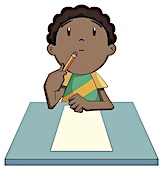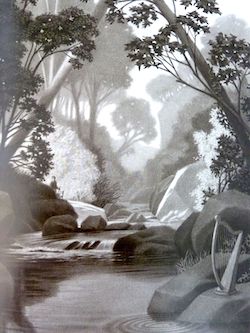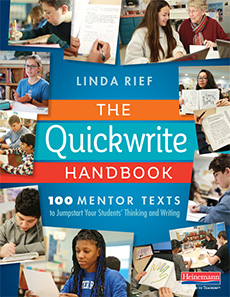Middle Schoolers Love to Write Flash Fiction
“If reading fiction is beneficial, if, as some research indicates, it builds empathy, reading stamina, vocabulary, and cultural knowledge, if it provides entry into appealing, vicarious worlds – why can’t the same be said for writing fiction?” (Writing Unbound: How Fiction Transforms Student Writers, p.3)
Too often we (some teachers) demean fiction writing as being “creative,” and therefore less than important or not demanding (rigorous) enough when compared to other genres of writing, such as analysis, memoir, essay, poetry. That notion has always perplexed me.
As a writer, and a teacher of writing, it seems to me that all forms of writing are creative, and all forms of writing are difficult. But fiction writing, because it demands the imagination to build all aspects of the story, is the most creative. And isn’t “creativity” at the top of Bloom’s taxonomy? (It is.)

When Ethan, one of my eighth graders, reads a portion of his Stephen King-like draft to me, I wince at what he has written. I pull my arms in as if to protect myself. His story scares me.
Tom Newkirk confirms what I am finding in the classroom when he writes in Writing Unbound (Heinemann, 2021), “Fiction writing allows for a greater psychological range than do most nonfiction forms. The writer can imagine extremes of fear, anger, resentment, and, yes, evil that they don’t and wouldn’t want to experience in real life.” (p.7)
My body-hugging reaction causes Ethan to chuckle with satisfaction. With a broad smile, he says, “Pure evil,” rubbing his hands together in celebratory confidence that his fiction has done what he intended it to do – scare a reader. Especially his teacher. Me. He has written passionately. . . creatively. . . imaginatively. . . joyfully. . . intentionally.
The flash fiction format
Thanks to the flash fiction format, for the first time I am finding joy in hearing and reading my students’ fiction. The stories are not fifteen to twenty pages long, lulling me to sleep as I struggle to read to the end, where the last line is often where the real story, the engaging part, begins.
What Ethan has written is:
- short (usually 350-750 words),
- focused on one scene (mostly),
- with few central characters (usually only one or two),
- precise wording (dynamic, strong, sensory details),
- an engaging title (reflective of the ultimately discovered central point),
- and an ending that surprises, turning the reader around (unexpected, but still targeting the essence of the story).
Most if not all of the elements of fiction are encompassed in this short form of writing.

I don’t worry about requiring students to write longer, more complex pieces. They are playing with, and discovering, the elements of fiction in these shorter stories that could be further developed at a later time.
I have learned from both Meredith Hall, author of Without a Map, and Anthony Doerr, author of Cloud Cuckoo Land, the value of writing small to write big. Hall uses her notebook to capture moments, anecdotes, descriptions that may one day work their way into her novels. Doerr, when asked what it takes to write a novel said, “You can trick your mind into writing something longer just by writing small scenes or vignettes.”
There is value in short writing.
The flash fiction process
I begin this four to six-week flash fiction study with “The Scarlatti Tilt” by Richard Brautigan:
“It’s very hard to live in a studio apartment in San Jose with a man who’s learning to play the violin.” That’s what she told the police when she handed them the empty revolver.
That’s the complete text. It has the elements of a story: action, suspense, characters, dialogue. What do we know? What do we think we know? What can we infer from what is said, not said? We have great discussions about this short piece as an introduction into this fictional genre. It appeals to the students.
Our six-week study includes:
►An Anchor Chart
We read five to seven pieces of flash fiction, from former students and professionals. I read these pieces aloud as the students read along. In groups of three to five students I ask them to reread one or two of the stories and come up with the traits or characteristics they notice in this kind of writing. This becomes the anchor chart (combined from all of my classes) that guides their writing.
►Finding Writing
- Quickwrites – The mentor texts are almost always passages from novels. Short excerpts that might lead the students to ideas of their own.
- Pictures or Photographs – Chosing from The New York Times or National Geographic, I try to find pictures that include a character, a unique place, and a happening, and convey a mood or tone. I cut apart the book The Mysteries of Harris Burdick, put the one line that goes with the picture on the back of the art, and place these pages all around the room. I ask my middle grades students to choose a picture or photo or art that intrigues them, “step into it,” and write out what they imagine.
- Art Postcards – Draw the postcard. As you draw, what do you notice, see, hear, think, wonder, feel? What’s going on?
►Minilessons
Minilessons come from the traits of the writing: leads, endings, precise language, dialogue, and titles.
I use examples (at least five to seven) for each from the examples of flash fiction we have read, coupled with others we might not have read, and from novels that illustrate these traits of writing well. (Ex: Elizabeth Acevedo’s opening line in Clap When You Land: “I know too much of mud.” Or, Jason Reynolds’ last line in Long Way Down: “You coming?”)
I ask the students: What do you notice about these examples? How does the writer do that? How does the way it is written affect you as a reader?
►Norms of the Classroom
No matter what genre we may be studying as writers and readers, there are certain expectations we always hold firm to:
- We are all writing and reading (independently and in the genre we are studying).
- We are each keeping a Writer’s-Reader’s Notebook.
- Seeking help through conferences betters the writing:
- How can I help you?
- This is what stayed with me. This is what you are doing well.
- These are the questions that came to mind.
- Here’s a suggestion framed as a “What if. . .?”
Try flash fiction with your students
Using the picture “The Harp” from Chris Van Allsburg’s The Mysteries of Harris Burdick, my student Fiona wrote:

. . . Usually he would bring a toy sailboat or toy soldiers on these secret excursions, flinging them into the river, marching them down the rocks, burying them in soft, riverbank sand. But today. . . .
Fiona’s lyrical prose is worlds apart from the terrifying lead to Ethan’s flash horror story. Yet I hope it’s enough to engage you, inspire you, motivate you to try flash fiction with your students. You will not fall asleep reading them.
Linda Rief is the author of many books, including Whispering in the Wind: A Guide to Deeper Reading and Writing Through Poetry (Heinemann, 2022) and The Quickwrite Handbook: 100 Mentor Texts to Jumpstart Your Students’ Thinking and Writing (Heinemann 2018).

Linda is now an instructor in the University of New Hampshire’s Summer Literacy Institute and a national and international presenter on issues of adolescent literacy. For five years Linda co-edited, with Maureen Barbieri, Voices from the Middle, a journal for middle school teachers published by the National Council of Teachers of English. In 2021 she was honored with the Distinguished Service Award from NCTE and in 2020 received the Kent Williamson Exemplary Leader Award from the Conference on English Leadership, in recognition of outstanding leadership in the English Language Arts.































